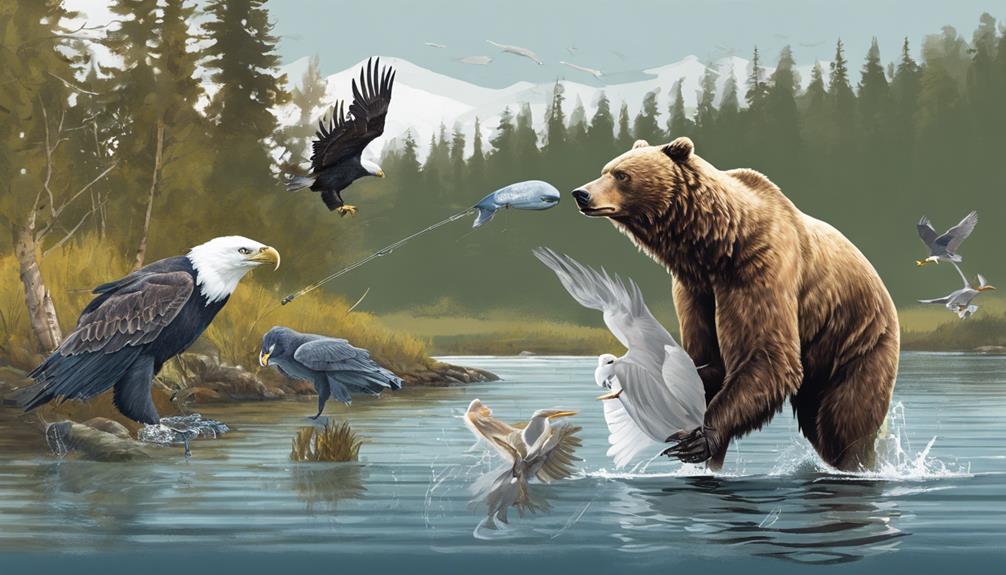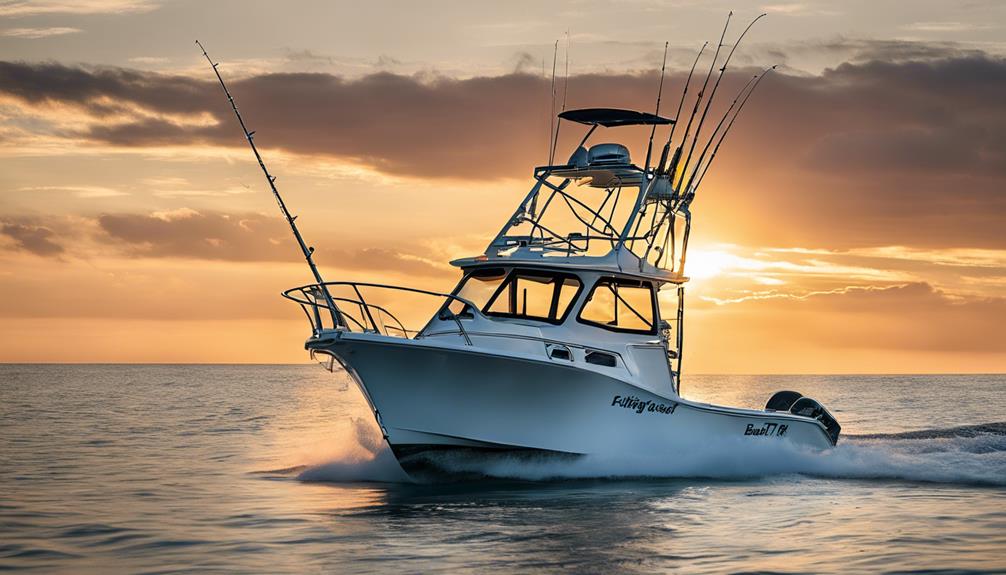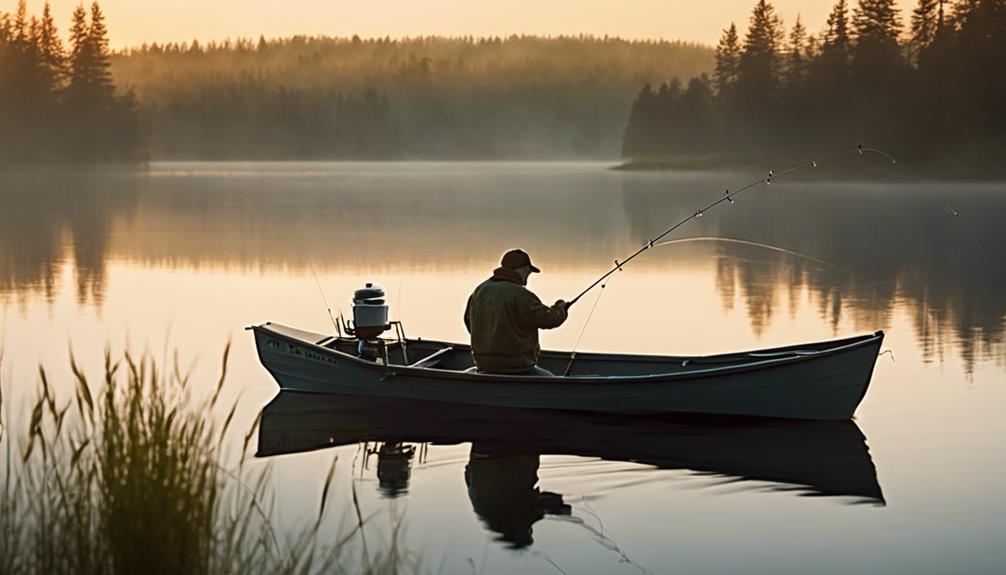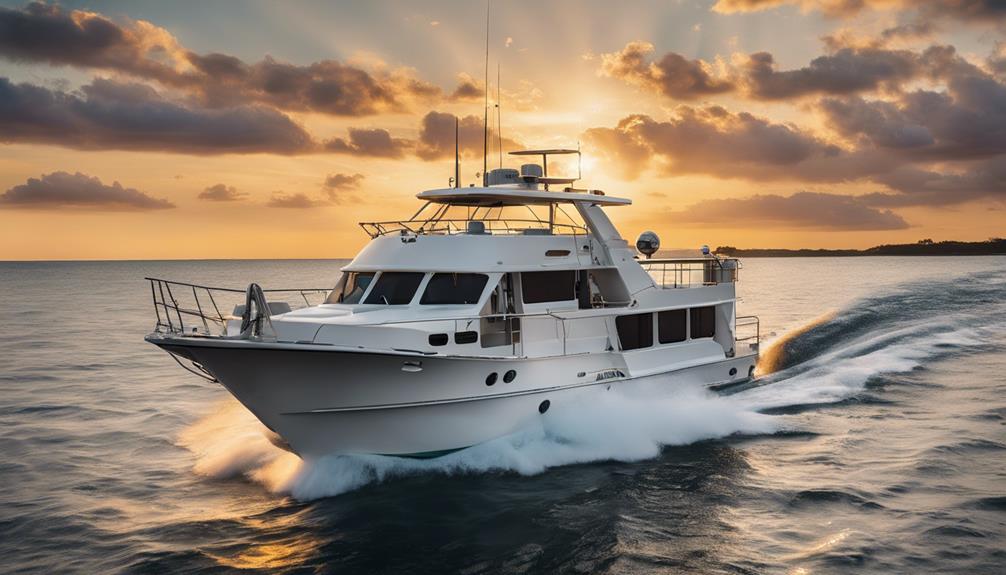To optimize your fishing outcomes, adhere to species-specific fishing guides. Trout fishing demands understanding selective feeding patterns, mastering fly fishing, and choosing the right flies based on hatch matching. For bass, grasp their feeding preferences, use appropriate lures like soft plastic ones, and select a suitable boat for maneuverability. Salmon fishing requires knowledge of migration, utilizing drift fishing techniques, and targeting regions like the Great Lakes. Crappie behavior shifts with seasons, requiring adaptable strategies and gear choices. By following these specialized guides, you'll enhance your fishing expertise and increase your chances of a successful catch.
Trout Fishing Guides
When targeting trout, understanding their behavior patterns is crucial for successful fishing expeditions. Trout are known for their selective feeding habits and sensitivity to their environment. To increase your chances of a successful catch, mastering fly fishing techniques is essential.
Fly fishing is a popular method for targeting trout as it mimics natural prey effectively. When using this technique, it's crucial to match the hatch, meaning selecting a fly that closely resembles the insects or baitfish present in the trout's habitat. This attention to detail can significantly increase your chances of enticing a bite.
Identifying the best fishing spots is also key when targeting trout. Look for areas with cool, oxygen-rich water such as riffles, runs, and deep pools. Trout are often found near structures like rocks and fallen trees that provide shelter and protection. Additionally, pay attention to water temperature and flow rate, as these factors can influence trout behavior and feeding patterns.
Bass Fishing Guides
To effectively target bass, understanding their feeding habits and habitat preferences is essential for successful fishing expeditions. Bass are opportunistic feeders, preying on a variety of aquatic creatures such as crayfish, frogs, and smaller fish. When selecting a boat for bass fishing, consider a model that provides stability for casting and maneuverability in shallow waters where bass often hide around structures like submerged logs or vegetation.
When it comes to lure techniques for bass fishing, you should experiment with different types to see what works best in specific conditions. Soft plastic lures like worms and creature baits are versatile choices that mimic natural prey effectively. Crankbaits are excellent for covering large areas quickly, while topwater lures can be exciting to use during dawn or dusk when bass are more active near the surface.
When selecting your boat, opt for a model that allows for easy navigation through shallow waters where bass tend to congregate. Consider the size of the boat based on the water bodies you plan to fish in, ensuring it provides enough space for your gear and allows for smooth movement while casting. Additionally, pay attention to features like a trolling motor for precise positioning near structures where bass are likely to hide. By combining the right boat selection with effective lure techniques, you can increase your chances of a successful bass fishing trip.
Salmon Fishing Guides
For successful salmon fishing expeditions, understanding the migration patterns and preferred habitats of salmon species is crucial. Salmon fishing is a popular activity, and employing the best techniques can significantly enhance your chances of a successful catch. When it comes to salmon fishing, one of the top locations to consider is the Pacific Northwest region, particularly places like Alaska, British Columbia, and Washington. These areas are known for their abundant salmon populations and diverse species, making them prime spots for anglers.
When trying to catch salmon, one of the best techniques to use is drift fishing. This method involves allowing your bait to drift naturally with the current, mimicking the movement of prey and attracting salmon to your line. Another effective technique is trolling, where you slowly cruise along the water while dragging bait or lures behind your boat. This method is particularly useful for covering a larger area and increasing your chances of encountering salmon.
In addition to the Pacific Northwest, other top locations for salmon fishing include the Great Lakes region, where salmon are stocked to support recreational fisheries. The Great Lakes offer ample opportunities for anglers to target various salmon species, such as Chinook and Coho salmon. By understanding the best techniques and choosing the top locations, you can maximize your success when embarking on a salmon fishing expedition.
Crappie Fishing Guides
Understanding the behavior and habitat preferences of crappie species is fundamental for successful crappie fishing expeditions. When it comes to crappie fishing techniques, it's crucial to adapt to the behavior of these fish. Crappies are known to school together, so once you find one, there are likely more nearby. Jigging with small lures or live minnows at varying depths can be effective in enticing them.
The best spots for crappie fishing often include submerged structures like fallen trees, brush piles, or docks. These structures provide shelter for crappies and attract baitfish, making them prime locations for a successful fishing trip. Additionally, during the spring spawning season, shallow areas near the shore are excellent spots to target crappies.
When it comes to crappie fishing gear, using ultralight or light spinning rods paired with 4-8 pound test line is recommended. Reels with a smooth drag system are essential for handling the crappie's sensitive bite. Seasonal tips for crappie fishing include adjusting your techniques based on the time of year. In colder months, slowing down your presentation can be more effective, while in warmer months, crappies tend to be more active and may respond better to faster movements. By following these crappie fishing guides, you can improve your chances of a successful fishing experience.
Catfish Fishing Guides
Exploring the diverse habitats and feeding behaviors of catfish species is crucial for optimizing your catfish fishing endeavors. When targeting catfish, understanding their bait preferences is essential. Catfish are known to be opportunistic feeders, with preferences varying based on species and habitat. Common baits include chicken liver, nightcrawlers, and stinkbaits. Experimenting with different baits can help determine what works best in your fishing location.
In terms of fishing techniques, catfish are often found near the bottom of rivers, lakes, and ponds. Using sinker rigs or bottom fishing rigs with bait placed strategically on the riverbed can increase your chances of a successful catch. Additionally, catfish have excellent senses of smell, so using baits that emit strong odors can attract them effectively.
When considering the best locations for catfish fishing, focus on areas with structures like fallen trees, rocks, and deep holes where catfish may seek shelter or ambush prey. During the warmer months, catfish tend to move to deeper waters, while in cooler seasons, they may migrate to shallower areas. Understanding these seasonal patterns can aid in locating catfish more efficiently.
Walleye Fishing Guides
To optimize your walleye fishing success, it's important to understand the unique habits and habitats of walleye species. Walleye are known for their nocturnal feeding behavior, making them more active during low-light conditions such as dawn, dusk, and at night. When targeting walleye, employing techniques that capitalize on their feeding patterns is crucial.
The best techniques for catching walleye often involve using live bait such as minnows, leeches, or nightcrawlers. Jigging is a popular method, especially when the walleye are suspended at different depths. Trolling with crankbaits or spinners can also be effective for covering larger areas to locate actively feeding fish.
Prime locations for walleye fishing include structures like rocky points, submerged humps, and weed edges. Walleye are ambush predators and tend to hide around these areas waiting for prey to pass by. Additionally, walleye are commonly found in areas with moderate current flow, as they use it to their advantage when hunting for food.
When fishing for walleye, it's essential to pay attention to water temperature and depth. During the warmer months, walleye may move to deeper, cooler waters, while in the spring and fall, they're often found in shallower areas. By understanding these factors and implementing the best techniques in prime locations, you can increase your chances of a successful walleye fishing trip.
Tarpon Fishing Guides
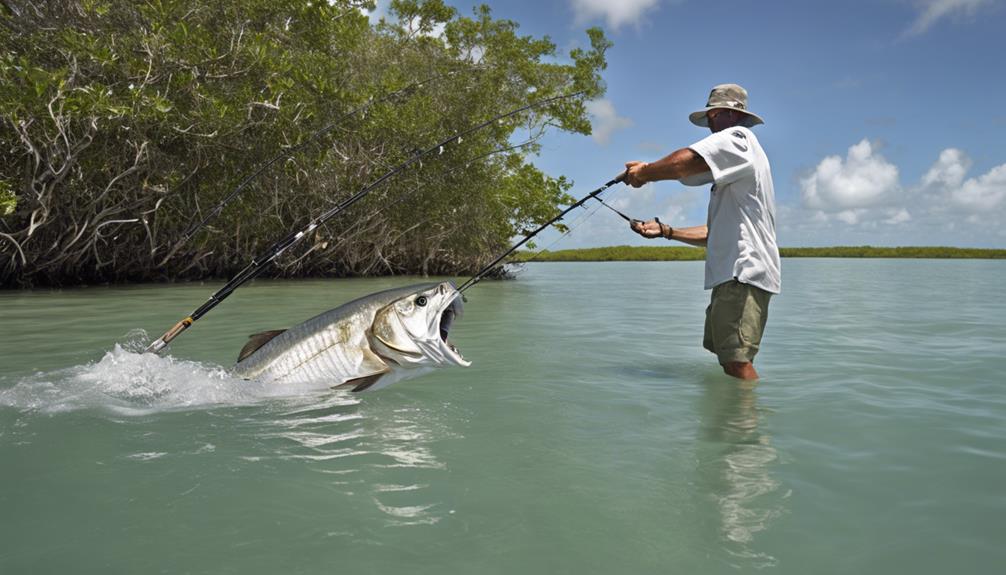
When targeting tarpon for fishing, it's essential to consider their migratory patterns and preferred habitats to increase your chances of a successful catch. Tarpon are known for their extensive migration along coastal waters, moving between warm and cooler waters depending on the season. Understanding these migration patterns can help you locate schools of tarpon more effectively. During the spring and summer months, tarpon can often be found in shallower coastal waters, while in the winter, they tend to move towards warmer waters further south.
In terms of lures, it's crucial to choose the best tarpon lures to attract these powerful and acrobatic fish. Some popular options include live bait such as mullet, crabs, or shrimp, as tarpon are known to be opportunistic feeders. Artificial lures like soft plastic jerkbaits, swimbaits, and topwater plugs can also be effective in enticing tarpon to strike. When selecting lures, consider the water conditions, time of day, and the behavior of the tarpon in that particular area.
Marlin Fishing Guides
For successful marlin fishing expeditions, understanding the behavior and habitat preferences of these powerful oceanic predators is crucial. Marlin are known to inhabit deep-sea waters, preferring warm tropical and subtropical regions. When targeting marlin, employing effective techniques is essential. Trolling is a commonly used method in marlin fishing, where artificial lures or natural baits are drawn behind a moving boat to attract the fish.
To increase your chances of a successful catch, using the right equipment is paramount. Heavy-duty rods and reels are necessary to handle the strength and speed of marlin once hooked. Opt for sturdy lines with a high pound-test rating to withstand the intense fights these fish are known for. Additionally, having a variety of lures in your arsenal can be beneficial as marlin can be selective based on conditions and preferences.
When trolling for marlin, it's crucial to pay attention to the speed of your boat. Marlin are fast swimmers, so adjusting your trolling speed to match their natural prey can make a significant difference in attracting these predators. By incorporating these techniques and utilizing the right equipment, you can enhance your marlin fishing expeditions and increase your chances of landing one of these majestic oceanic giants.
Frequently Asked Questions
Can I Use Live Bait for Trout Fishing?
Yes, live bait can be used for trout fishing, especially when spin fishing. However, it's important to note that using artificial lures, like flies, is a common and effective practice in trout fishing.
For spin fishing, power bait is also a popular choice. Each method has its advantages, with live bait appealing to the natural instincts of trout, while artificial lures require more skill and finesse.
Experiment with both to see what works best for you.
What Is the Best Time of Day for Bass Fishing?
For bass fishing, the best time of day is early morning or late evening. Bass are most active during low light conditions, making topwater lures effective. They tend to feed aggressively at these times.
Night fishing can also be fruitful as bass are more active in the dark, using their keen sense of smell and vibration detection to hunt. Using topwater lures during these times can increase your chances of a successful bass fishing trip.
How Do I Properly Store Salmon for Freshness?
To properly store salmon for freshness, start by ensuring it's cleaned thoroughly. Remove the gills, guts, and scales before rinsing with cold water. Pat it dry and consider freezing it for long-term storage.
To maintain quality, use vacuum-sealing bags to prevent freezer burn. If you prefer a different approach, consider curing methods or smoking techniques to enhance flavor and prolong freshness.
Proper storage methods are crucial to preserving the taste and texture of your salmon.
What Is the Best Technique for Catching Crappie?
When targeting crappie, consider their habitat and behavior. Try jigging techniques near underwater structures during spawn season. Experiment with different colors and sizes for your jigs.
If trolling, use small crankbaits or jigs at varying depths. Crappie often prefer brush piles or submerged vegetation. Stay patient and adjust your approach based on their response.
Mastering these methods will increase your chances of a successful crappie catch.
Are There Any Specific Regulations for Catching Catfish?
When fishing for catfish, it's crucial to be aware of specific regulations set by authorities. These rules often include size limits to ensure the population's sustainability and restrictions on certain gear or techniques.
Catch and release policies are also common, promoting conservation efforts by returning the fish unharmed to the water. By following these guidelines, anglers can contribute to the preservation of catfish populations and the overall health of aquatic ecosystems.
Conclusion
In conclusion, when selecting a fishing guide, it's crucial to consider species-specific recommendations to maximize your chances of success. Different species require unique techniques, equipment, and strategies for a successful fishing experience.
By following the specialized advice provided by trout, bass, salmon, crappie, catfish, walleye, tarpon, and marlin fishing guides, you can increase your chances of landing the perfect catch. Remember to tailor your approach based on the specific species you're targeting for a more rewarding fishing adventure.
